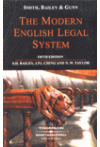- Author(s): S.H. Bailey, J.P.L. Ching
- Publisher: Thomson Sweet & Maxwell
- Edition: 5 Ed 2007, First South Asian Edition 2015
- ISBN 10 9384746452
- ISBN 13 9789384746452
- Approx. Pages 1197 + contents
- Format Paperback
- Delivery Time 3-5 working days (within Kerala & South India) (Others 7-9 days)
.............................................................................................................................
Description
Covering the institutions, personnel and procedures, together with the handling of case law and statutes, this book provides a lucid and wide-ranging account of the English Legal System and is widely regarded as the leading work on this subject.
Accompanying the authors' clear and comprehensive narrative are sample court forms, -tables of essential statistics and flow charts illustrating the court structures.
Among the numerous developments this fifth edition details are significant changes resulting from the Constitutional Reform Act 2005, including the role of the Lord Chancellor, the restructuring of the Judiciary and the establishment of a Supreme Court and a Judicial Appointments Commission.
Similarly, it comments on the changes made by the Criminal Justice Act 2003 affecting procedure, evidence and sentencing in the light of the Auld Report; changes brought about by the Courts Act 2003 relating to courts, magistrates and procedure; and the establishment of SOCA by the Serious Organised Crime and Police Act 2005.
Other legislative developments dealt with by this edition are the Proceeds of Crime Act 2002, The Criminal Defence Service Act 2006, the Police and Justice Act 2006, Tribunals, Courts and Enforcement Act 2007, the Legal Services Bill 2007 and Solicitors Code of Conduct 2007.
Key cases analysed include such landmark decisions A v Secretary of State, Leeds City Council v Price, and R (Jackson) v Attorney General.
Additionally, the impact of the accession of a lar ge number of countries joining the EU, the further consolidation of the Woolf Reforms, the growth in significance of ADR, the Law Society's Training Framework Review, and continued pressures on publicly funded legal services are all taken into account.
.............................................................................................................................
Contents
PART I: COURTS, PERSONNEL AND SOURCES OF LAW
1. INTRODUCTION
A. The English Legal System
B. Some Basic Concepts
C. The Basic Institutions of the English Legal System D. Law Reform
E. The Role of the Judiciary in Court Administration
F. Information about the Legal System
G. International Standards
2. COURTS AND TRIBUNALS
A. Introduction
B. Courts
C. Tribunals
D. The System in Outline
E. Particular Courts and Tribunals
3. LAWYERS
A. Introduction: the "Legal Profession"
B. The Legal Profession Today
4. JUDGES
A. Magistrates
B. Tribunal Chairmen and Members
C. The Circuit Bench
D. Judges of the Superior Courts
5. LEGISLATION
A. Introduction
B. Acts of Parliament
C. Subordinate Legislation
D. Community Legislation
6. STATUTORY INTERPRETATION
A. Introduction
B. General Approaches to Statutory Interpretation
C. The Context: Internal Aids to Interpretation
D. The Context: Rules of Language
E. The Context: External Aids to Interpretation
F. Presumptions G. Reform H. The Interpretation of Community Legislation
7. JUDICIAL PRECEDENT
A. Introduction B. Proposition of "law"
C. Determining the Ratio Decidendi
D. The Hierarchy of the Courts and the Rules of Binding Precedent
E. Persuasive Authorities F. Distinguishing
G. Precedent and Statutory Interpretation
H. Ratio Decidendi and Res Judicata I. Law Reports
8. THE HUMAN RIGHTS ACT 1998 A. Introduction
B. Key Concepts and Provisions
C. Specific Convention Rights
D. Practical Implementation of the Act
E. Impact of the Act
PART II: SOLVING LEGAL PROBLEMS
9. PROBLEMS ABOUT PROBLEMS
A. What is a Problem?
B. When is a Problem "legal"?
C. The Community Legal Service and the Meeting of Need
D. Legal Problems and the Use of Lawyers
E. Overmet Legal Need—the "compensation Culture"?
F. Meeting Unmet Legal Need
10. INFORMATION AND ADVICE SERVICES
A. The Special Features of Information and Advice Provision
B. Agencies Offering Legal Advice
C. Specialist Agencies Offering Legal Advice to Members and Clients
D. Law Centres
E. Solicitors in Private Practice
PART III: PRE-TRIAL PROCEDURE
11. FEATURES OF LITIGATION AND OTHER METHODS OF DISPUTE RESOLUTION
A. Costs
B. Delay
C. Settlement
D. Alternative Dispute Resolution ("ADR")
12. PRE-TRIAL CIVIL PROCEDURE
A. The Overriding Objective B. Tracks
C. The County Court
D. The High Court
E. Court Procedure Generally
F. Interim Remedies
G. Have the Woolf Reforms Achieved their Objectives?
13. PRE-HEARING: TRIBUNALS
A. The Common Objectives
B. "Knowing your Rights"—Identifying the Tribunal
C. "Knowing the Ropes"—Making Application to a Tribunal
D. "Knowing the Case"—the Pre-hearing Exchange of Information
E. Tribunal Procedure Rules
14. PRE-TRIAL CRIMINAL PROCEDURE
A. Investigation—Investigative Agencies
B. The Responsibility for Instituting Prosecutions.
C. The Exercise of Discretion in Prosecutions
D. The Classification of Offences
E. Getting the Accused into Court
F. Bail or Custody?
G. Committal Proceedings
H. Disclosure of Evidence
I. A Pre-trial Review
J. Obtaining Legal Advice and Representation
K. Evaluations
L. Future Developments
15. THE CIVIL TRIAL
A. Adversarial Procedure
B. Witnesses and Expert Evidence
C. The Use of the Jury in Civil Cases
D. Should the Jury be Retained in Civil Cases?
E. The Role of the Judge
F. The Judgment and Remedies
G. Enforcing Judgment
16. THE TRIBUNAL HEARING
A. Procedure
B. The Role of the Chairman
C. The Role of the "Wing" Members
D. Representation Before Tribunals
E. Experiences of Tribunals
F. Alternatives to Oral Hearings
17. THE CRIMINAL TRIAL
A. Summary Trial
B. Trial on Indictment
C. Evaluations
18. APPEALS AND JUDICIAL REVIEW
A. Introduction
B. Variable Factors in Appeal and Review Mechanisms
C. Appeals
D. Applications for Judicial Review
E. References to the European Court of Justice
F. The Royal Prerogative of Mercy
.............................................................................................................................
Author's Details
Stephen Bailey, Professor of Public Law, University of Nottingham
Jane Ching, Reader, Nottingham Law School, Nottingham Trent University
Nick Taylor, Senior Lecturer in Law, University of Leeds
.............................................................................................................................

